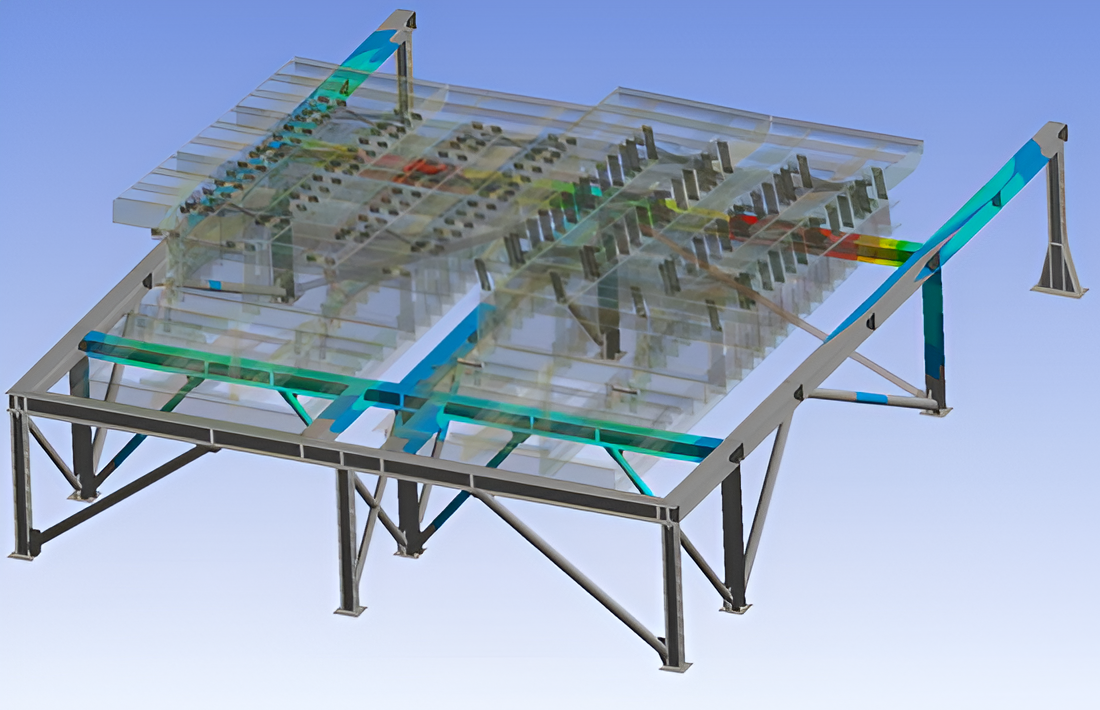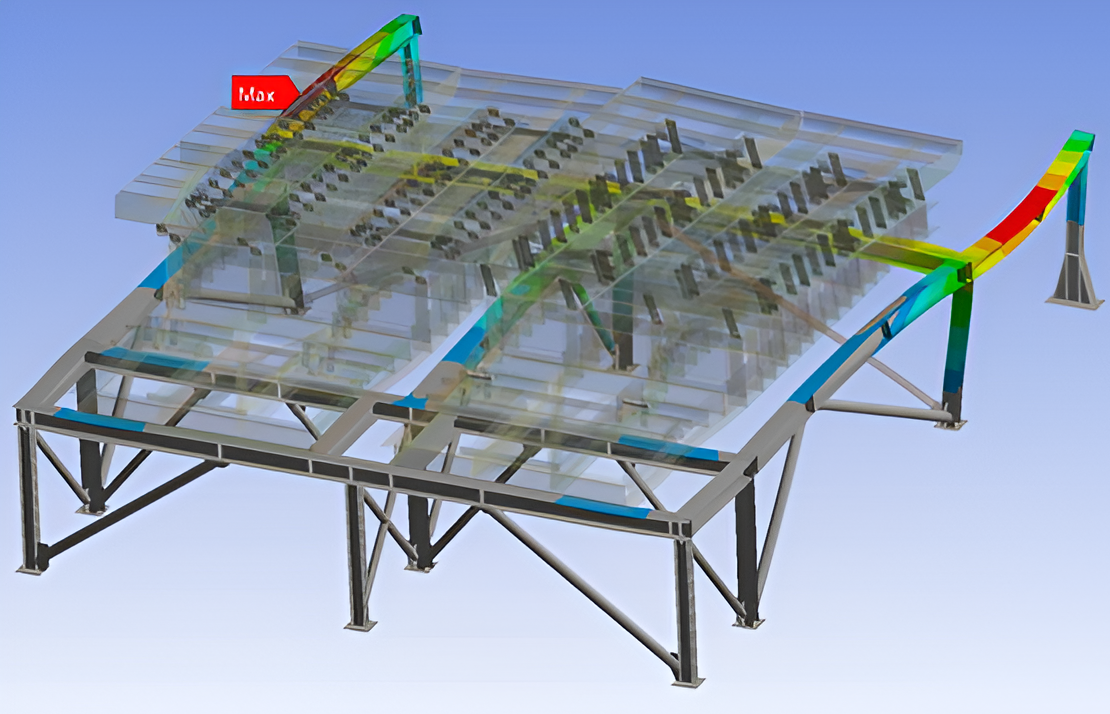Ørsted Avedøreværket
At Ørsted Avedøreværket, hay is converted into heat for consumers in Copenhagen. An advanced ANSYS simulation model was developed to analyze a 70-ton agitator and evaluate heat, vibration and varying loads. After two years of operation, cracks were discovered in the rack of the agitator. Kirkholm was called in as an impartial adviser to solve the problem and prevent future operational disruptions.
Static, dynamic and thermal conditions
- 70 ton agitator grid at cogeneration plant -
At Ørsted's Avedøreværk, hay is used as biofuel when converted into heat for consumers in Copenhagen. A unified ANSYS simulation model that includes static, dynamic and thermal conditions was developed to analyze a 70 ton agitator. The model takes into account heat, vibrations and varying loads on a complex structure in motion, which ensures an efficient and stable operation of the plant.
After two years in operation, a series of inspections showed that there were cracks in the fixed frame which supports the agitator in which the hay is burned. Overall, this is a structure with an agitator weighing approximately 70 tonnes. The stand is bolted to the concrete foundation in the bottom. Four movable agitator grids are positioned on top, each mounted on 30 inclined springs. At the front end of the structure, the four agitator grids are driven back and forth by a crank mechanism with connecting rods similar to the principle of a gasoline or diesel piston engine.
The crank mechanisms are driven by two electric motors. Primary air is blown from below through the perforated bottom of the shaker grates to the combustion chamber in the boiler. To distribute the hay on the agitator grid, the content is agitated every half minute for eight seconds. Simultaneously, ash and slag are agitated down at the end of the boiler, where it is collected in a slag channel and transported away.
VIEW OF THE MATTER
The supplier of the entire facility has made some improvements over the past few years. At the inspection in 2019, cracks and breaks around the push rods were discovered, prompting a need for further investigation.
One of the results from thorough investigations was that the agitator grid, during the shaking sequences, coincided with the natural frequency of the rack. Furthermore, slag was regularly built up on the grate. Thus, the structure was additionally affected by the oscillations and the total mass that had to be vibrated was increased from the agitator's own mass of approx. 15 tons.
Over time, this has had a negative effect on the entire construction. Production at the plant has been closed on several occasions to remove slag and repair cracks in the stand and push rods.

INDEPENDENT EXTERNAL ADVISOR
Kirkholm was brought in as an impartial external advisor at the beginning of 2021. By using simulation, the task for Kirkholm was to find the underlying causes of the construction's breakdown and to bring proposals for a sustainable improvement.
The static effects from slag and their contribution to increased loads during the dynamic movements were not included in the original calculations at the plant. In other words, their massive contribution has been part of the cause of the accident. Furthermore, underlubrication of a bearing in connection with the pushrod was probably also one of the causes for the breakdown.
The task included analysis of natural oscillations, thermal analyses, static loads and applied dynamic loads, which were verified to a certain extent by strain gauge measurements (measurement of length expansion). It also turned out that the thermal effects on parts of the construction had not been taken into account. There was up to a 200 degree difference in the structure, since only some parts of the stand are heated. This affects the forces that go into the foundation enormously - also much more than expected.
As a result, the foundation had also become an important part of the improvement, and therefore COWI, which was originally responsible for the contract, was included in the project. In the two figures, the difference in the deflection of the structure is clearly seen.
Robert and Jonas, the engineers from Kirkholm who have been in charge of the analytical calculations and simulations, mentioned that it has not been the easiest model to work with:
"A simulation model like this is a complex quantity. However, this is not due to the physical size or the tonnage, but instead to the fact that all kinds of variables must be taken into account – both static, dynamic and thermal. This can make both calculations and analysis difficult. The individual elements pull in different directions. In terms of thermal influences, a flexible construction is preferable, while stiffness is best in relation to vibrations. Therefore, it approaches a Gordian knot, and we have had to make compromises to get the end result."

Future safe operation
The scope of the task has become slightly larger than first assumed. The reason for this is the decision to gather all the details in the moment, instead of risking a possible breakdown again in the middle of the firing season. The solutions have now been implemented and have been running for a few months. These include, among other things, new plinths in the foundation, renovation and recasting of existing plinths, new supports and a greater amount of bracing designed to channel forces into the construction in an appropriate way. The push rod has also been redesigned, and manufactured with high fatigue strength in mind. All in all, a large and comprehensive project that would like to ensure stable operation in the future. Robert concludes:
"It was an exciting task, and even though we have calculated and analyzed many details, the calculation is based on a new construction. This is a construction that has been in operation and where we know that it has been exposed to fatigue damage. In reality, we do not know to what extent or the consequence of them".
By combining advanced technology and specialized knowledge, Ørsted Avedøreværket and Kirkholm worked together to ensure a reliable and sustainable heat supply for the Copenhagen area. This partnership emphasizes the importance of continuous monitoring and maintenance in complex industrial systems.
Do you have questions and/or would you like to know more about how Kirkholm works with Finite Element, ANSYS and our competences within calculation, analysis and simulation of both static, dynamic and thermal conditions?
Then have a chat with our CSO Nicolai, who has great insight into and experience with these tasks:
DO YOU NEED HELP?
We can help you with practical information and answer your questions - give us a call or write to us.
SKANDERBORG
Kirkholm Maskiningeniører A / S
Godthåbsvej 33
8660 Skanderborg
Denmark
FREDERICIA
Kirkholm Maskiningeniører A / S
Bødkervej 7b, 1. tv.
7000 Fredericia
Denmark
HØRSHOLM
Kirkholm Maskiningeniører A / S
Venlighedsvej 6
2970 Hørsholm
Denmark
All Rights Reserved | Kirkholm


